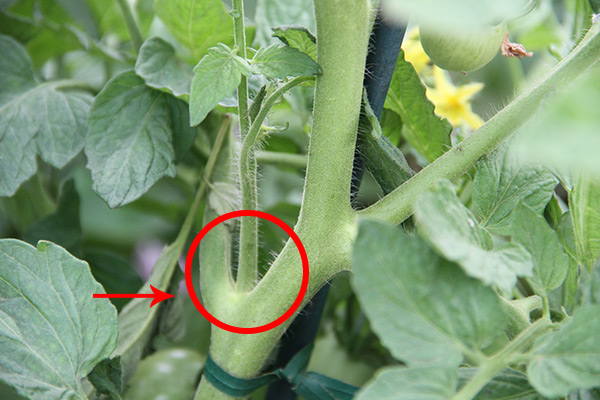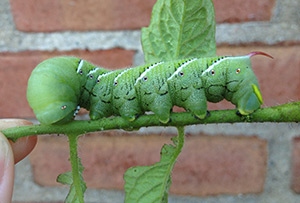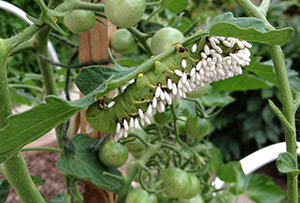Tomato Talk
A Full Season of Tomato-Growing Information

Pinching sucker growth in the leaf axils means better production.
Top Tips for Tomato Success
Tomatoes appreciate an even supply of moisture rather than a heavy soaking and then a drought. Make sure plants get 1 inch of water a week, or more if the weather is especially hot or windy. Straw mulch is helpful in these beds to keep soil from drying out.
Want a bigger crop? You may wish to pinch out the sucker growth originating in the axils of the lateral branches (see photo above). This relieves the plant of having to expend energy on branch growth and focuses its energy into fruit production.
An indeterminate (vining) tomato plant is a solar-powered sugar factory. It can double in size every 12 to 15 days. Unpruned, the plant may have ten unruly stems, each 3 to 5 feet long. Pruning helps plant structure and health. Side shoots, called suckers, grow in the crotches (axils) between the main stem and leaves. Allow two or three suckers to develop into flowering stems and pinch out the rest. The result will be four manageable stems.
Professional growers recommend pinching the tops of the two leaders about one month before the fall frost. This causes the plant to stop growing and again, forces it to push the fruit.
Know your pests & diseases
Know what pests and diseases look like to troubleshoot before they get in your garden beds. Want to plant disease-resistant varieties? Check out Cornell University's list of disease-resistant vegetable varieties.
- Fusarium wilt (Fusarium oxysporum) spreads quickly through contaminated soil. Two distinct forms which attack tomatoes cause either vascular wilt, or crown and root rot. Typically, as soon as fruit begins to mature, the lower leaves along one side of the plant will wilt and brown. Unfortunately, the best recourse for this disease is to pull up and discard infected plants. Fusarium can persist in soil for many years. You will want to rotate your crops regularly (use a 3-year rotation).
- Verticillium wilt is a fungal disease which causes leaves to yellow and die off without wilting. Tomato production is decreased, and the entire plant may die off on its own. As with Fusarium wilt, best practices to remove the fungus includes pulling and removing tomato plants, and rotating crops, making sure not to plant tomatoes in the same bed for 3 years after the last crop.
- Tobacco/tomato mosaic virus will affect tomato production, but will not typically kill plants. Look for curled leaves or green and yellow mottling on your tomato leaves. You may have fewer tomatoes, or unevenly ripened fruit. University of Minnesota Extension has recommendations for tomato varieties that are resistant. What to do with ToV? Sadly, also remove plants and rotate crops.
- Tomato hornworm caterpillars—these gluttons can eat a good portion of a single tomato plant in one day. They are best dealt with by picking them of by hand. (Otherwise, you could follow their life cycle into a beautiful hawkmoth butterfly.) If your hornworms are covered in white, fuzzy dots, they have already been hit by their own nasty predator: parasitic braconid wasps. The tiny wasp lays eggs in the caterpillar. As they grow, the larvae eat the host caterpillar's insides and then burrow out of the caterpillar, creating fuzzy, white cocoons on its skin. In a few days, these hatch into new braconid wasps, ready to repeat the process. The good news: hornworms produce only one generation each year.
- Flea beetles damage tomato plants by eating tiny holes in leaves. They generally do not kill tomato plants, but may carry viruses from one tomato to another. Many gardeners plant mustard or radish near tomato crops to draw these pests away from their tomato plants.

Tomato hornworm caterpillar

A parasitized caterpillar host bearing wasp cocoons
Looking for specific recommendations for your tomato pests and diseases? Contact our Plant Information Service for a personal diagnosis and recommendations.

